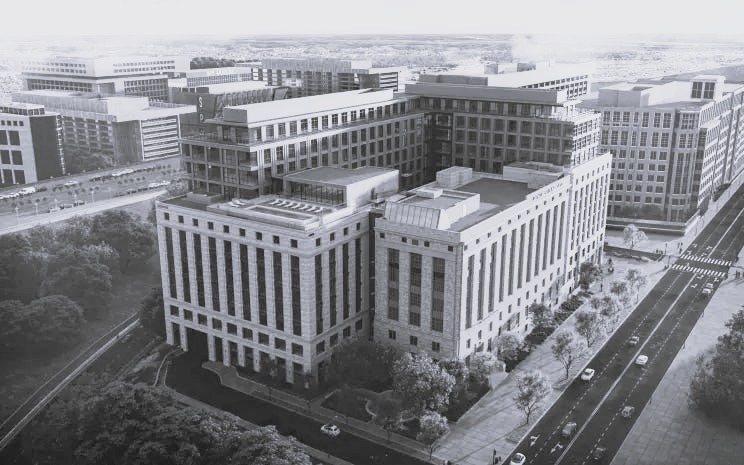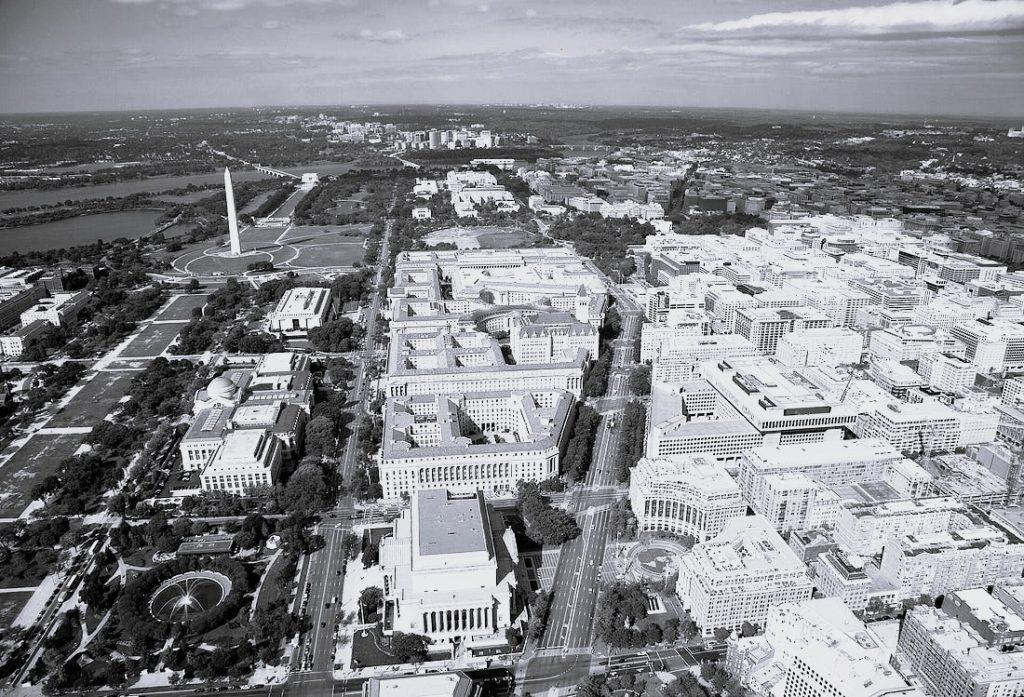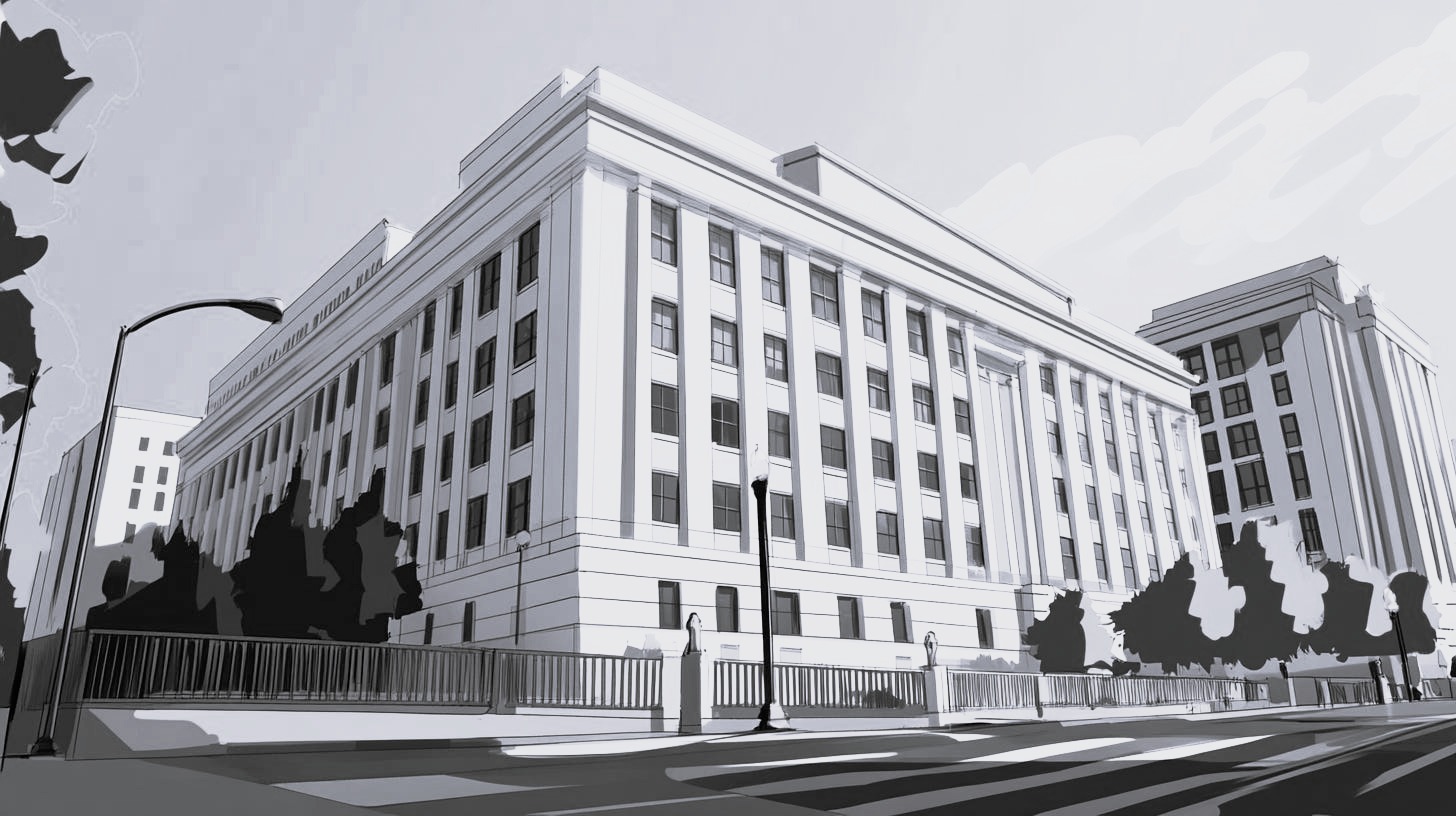As the government’s office portfolio faces dramatic cuts, what opportunities and challenges lie ahead?
The Washington news cycle moves quickly, with major updates emerging almost every hour. DOGE’s activities frequently make the nightly news or local headlines.
Among the deluge, the government is rapidly, and very deliberately, engaging in an effort to significantly reduce its portfolio of owned and leased real estate assets. While there’s little information about how the administration is deciding what to keep versus what to offload, DOGE is at the helm of the effort, which is sure to have a significant impact on the commercial real estate markets with the largest federal footprint.
It is no surprise, then, that commercial real estate professionals in Washington, DC are pretty anxiety-ridden these days. The district, unsurprisingly and not uniquely, has been struggling since COVID to get workers to return to the office. CoStar reports that in the past five years, 3.1 million square feet of office space in DC’s central business district have been vacated, leading to a 30-year high in vacancy rates and flat or declining rents. Complicating matters are the countervailing effects of return-to-office mandates for federal government workers and massive federal headcount reductions.
But where there’s disruption and transformation, there’s also opportunity. Among Washington, DC’s real estate leaders there are plenty of optimists, especially those that see the redevelopment of federal office property as an opportunity to eliminate economic dead zones and spur downtown revitalization.
This letter will provide context for the real estate landscape in the District of Columbia and explore the opportunities that exist to capitalize on the coming transformation of the federal office portfolio.
In particular, we’ll discuss:
- Recent efforts by the federal government to right-size its portfolio of real assets.
- The federal real estate portfolio in Washington, DC and potential alternative uses for those buildings; and
- The impact on the broader DC market and opportunities for redevelopment.
Thesis Driven is a reader-supported publication. To receive new posts and support my work, consider becoming a free or paid subscriber.
The federal government’s efforts to right-size its real estate portfolio
The General Services Administration (GSA) operates the federal government’s portfolio of 360 million square feet of real estate nationwide, roughly half of which is owned and half of which is leased. Within the broader DC metro area (which comprises the District, as well as parts of Maryland and northern Virginia) the GSA operates 90 million square feet of real estate, again with a roughly 50-50 split of owned versus leased space.
It is probably no surprise that most federal buildings are old, aging, and in need of investment and repair. Deferred maintenance is likely to cost more than $72 billion across the GSA’s entire portfolio. According to the Public Building Reform Board (PBRB), the cost of modernising the 25 federal buildings in most need of repair is roughly $8.6 billion alone; leaking roofs and windows, aging HVAC and air exchanger systems, inoperable elevators and outdated fire and life safety systems are all common issues in federal buildings.
Even before COVID, the government began efforts to right-size what it saw as a massive and inefficient real estate portfolio. In 2016, the PBRB was created by the Federal Assets Sale Transfer Act (FASTA) to provide expertise and recommendations to the federal government and Congress on how to reduce the costs of the government’s real estate assets. Since then, the PBRB has released two reports, recommending the sale of approximately $775 million worth of real estate. Interestingly, those recommendations did not include any properties within the broader Washington, DC metro; all were federal buildings outside of the nation’s capital.
The PBRB’s work became highly relevant when the COVID pandemic struck, sending many federal workers home and leaving offices empty. A 2023 PBRB analysis determined that the Department of Labor building, for example, had so few people coming to work, it cost taxpayers about $180,000 per in-office employee just to keep the heat and lights on.
This January, PBRB hosted a public hearing in which it identified the latest set of federal assets for disposition. Among them were about two dozen properties outside of Washington, DC and another two dozen within Washington, DC, which the PBRB estimated could yield a combined $1.8 billion in sales proceeds and, perhaps more importantly, $19 billion in cost savings associated with the ongoing operating expenses and deferred maintenance.
Also in January, President Biden, just before stepping down, signed the USE IT Act, which directed the GSA to work with agencies to assess the utilization of federal office buildings. Should any single building be less than 60% utilized, the GSA is mandated to take steps to reduce and consolidate the space.
Against this backdrop, DOGE stepped in under the current administration with a mandate to radically reduce federal expenditures. Slashing leases and selling underutilized real estate assets immediately became a priority. According to the (very fun) JLL DOGE Federal Lease Termination Tracker, as of this writing, 679 leases accounting for 7.9 million square feet of space across the United States have been terminated since January 20th; of that number 39 leases for a total combined 1.8 million square feet fall within the DC, Maryland, Virginia metro area.
In early March, GSA, presumably under the direction of DOGE, shocked the real estate community when it produced a list of 443 U.S. government-owned properties (comprising 80 million square feet) nationwide that could be divested, including 123 in or near the nation’s capital, and many notable buildings such as the Old Post Office Building, currently home to the Waldorf Astoria and formerly home to the Trump International Hotel, and the J. Edgar Hoover Building, the FBI’s headquarters. Amid the uproar, the list was revised later that same day to remove almost all of the DC, Maryland, and Virginia assets. The very next day the list was taken down entirely.
In late March, the GSA re-released its list of government-owned assets identified for disposition, this time including only eight assets comprising a combined two million square feet. Notably, only one building on the list falls within the DC metro area (in Riverdale Park, MD), and there are no high-profile buildings. Stephen Ehikian, the GSA’s acting administrator, has stated that more properties are to follow.
It’s clear that the administration is still set on significantly reducing its footprint, but uncertainty about the process or the timeline remains.
What to do with DC’s federal real estate assets
When most people think of federal buildings, one of two archetypes typically come to mind: large, blank neoclassical buildings like the White House or the Supreme Court building, or hulking brutalist structures like the J. Edgar Hoover FBI headquarters. Within the DC metro area, there’s plenty of both; however, another mode of classification is perhaps more useful in the commercial real estate context: that of pre-war versus post-war.
The distinction is primarily important because World War II is around when air conditioning came to be, which had a significant impact on the general design of buildings. Before air conditioning, large buildings had to be designed to maximise light and air flow. Narrow floor plates – typically no deeper than 50 feet – and operable windows were the norm. In Washington, DC, these buildings were often configured in the shape of an E, a figure eight, or some combination of the two. Examples include the Department of Interior headquarters, the Department of Agriculture headquarters, GSA’s national headquarters, and the Herbert Hoover Building on Constitution Avenue.

Herbert C. Hoover Building
The advent of air conditioning removed (or at least drastically reduced) those light and air design constraints; building floor plates could, and did, become much deeper. Office buildings began occupying whole blocks with large open floor plans. In DC, these buildings are often in the brutalist style, though not exclusively so. The Orville Wright federal building, just south of the National Mall, is an example.
So, what does this mean for the future of Washington, DC’s federal office buildings? Regular readers of this newsletter already know the implication: pre-war buildings are very good candidates for multifamily conversion; post-war buildings are not.
In a nutshell, the reason is that the narrow floor plates that were required in the design of pre-war buildings make it much easier and less costly to chop up an office building into livable apartments with enough light and air to meet local zoning and building code regulations. The deep floor plates of most large post-war buildings would leave a massively inefficient dead space in the center of any multifamily conversion, unusable for its distance from any exterior wall (and therefore distance from light and air). Drilling one or more light wells down the center of the building is really the only way to get around this, but that is an incredible expense that often renders the entire conversion uneconomic.
The solution, then, seems clear for underutilised federal buildings: convert the pre-war buildings to multifamily or mixed use, and either keep the post-war buildings as offices or demolish them entirely and build new.
Notably, there’s precedent for converting federal office buildings to multifamily. The former U.S. Department of Agriculture Cotton Annex, constructed in 1937, was purchased by a private developer in 2017 (and subsequently traded hands again in 2021) for conversion into a luxury apartment building. Renamed Annex on 12th, the new structure, which delivered just last year, contains 562 units and is often quoted in DC circles as a successful example of office-to-residential conversion of a former federal building.

Annex on 12th
What’s next for Washington, DC
While this solution may sound simple and the opportunities bountiful (there are at least 443 after all), any effort to offload real estate assets en masse will inevitably affect the broader real estate markets within which those assets exist – Washington DC, for instance. The sale of large quantities of office space is likely to put significant downward pressure on an already subdued office market – before even considering the broader economic effects on the region.
Historically, the District’s strong government presence gave real estate investors a sense of predictability and stability; a full 25% of all non-military jobs in DC are with the federal government and 30% of the city’s office stock is federally leased (that is, before DOGE started slashing contracts).
But the administration’s efforts to cut the federal workforce and relocate agencies outside of the district has resulted in an environment of uncertainty, to say the least. While forecasts of a local housing market crash have yet to bear out in the data, in late February the District of Columbia Chief Financial Officer Glen Lee revised downward the local revenue forecast by $21.6 million for fiscal year 2025; the 2025 – 2029 period was revised downward by an average of $342.1 million annually.
There are some green shoots, though. As discussed above, the city is aggressively supporting the production of new housing in a way that, so far, appears to be making progress. Crime is down significantly, decreasing by 35% in 2024 to a 30-year low. Pandemic-era out-migration trends, common among major US cities, reversed in DC in 2022, with the District being one of only two major US cities to show positive population growth (TBD how that trend persists given recent federal layoffs). And the city recently finalized a deal to fund $515 million in renovations to Capital One Arena, ensuring the Washington Capitals and Washington Wizards will remain in the city long-term and continue to support a vibrant downtown (a plan floated last year to relocate both teams to Northern Virginia was met with vehement opposition for the effect it would have on the city’s economy and was subsequently abandoned at the 25th hour).
All that’s to say, the future for DC is less than certain. For investors and developers, the federal government’s current efforts to offload real estate assets does appear to present a once-in-a-generation opportunity; however, the government’s current reduction in force efforts will undoubtedly have a substantial and lasting effect on all aspects of the broader Washington, DC economy.
The rub will be in aligning the incentives of the government’s efficiency efforts with a long-term vision for a healthy and thriving District. Interestingly, the current administration’s stated intent to transfer the District (currently self-governed, but without representation in Congress) to federal control could serve that purpose.
However, three solutions could help the federal government and DC make the most of this moment. While our focus is specific to the DC metro area, these can be broadly applied to other metro areas facing similar challenges.
First, where there is a sufficient density of federally-owned assets for disposition, GSA and DOGE should prioritize master-plan redevelopment over one-off sales. As we know, thoughtful mixed-use development can be an economic boon to a city when executed correctly. In recent years, large-scale developments such as The Yards and the Wharf, both within the district, have proven to be very successful in revitalising previously undervalued neighborhoods. Shalom Baranes, founding Principal of Shalom Baranes Associates, a DC architecture firm, has been trumpeting this approach for months now, targeting the Federal Triangle – a cluster of pre-war federal buildings sitting between the National Mall to the south and DC’s business district to the north – as a prime opportunity for master-plan development. Developers would do well to consider acquisitions of multiple co-located properties where mixed-use development would make sense.

Federal Triangle (centre), with the National Mall and Washington Monument to the south (left).
Second, the federal government should consider ground leases as an alternative to disposition. Structured properly, a long-term ground lease would allow the government to retain ownership of the valuable land underneath many of its assets, while shifting the burden of the deferred maintenance and operating expenses to private developers, who might simply demolish and rebuild anyway. Avoiding those costs is, after all, the main driver of value in disposing of these assets (recall the PBRB estimates from above). At the end of the lease, all improvements would revert the government, who would be free to then operate them directly once again or continue the ground lease on into the future.
Lastly, and most specifically for DC, city officials could consider repealing the Height of Buildings Act. (I can already hear my DC friends yelling at me through the comments on this one, but hear me out.) Contrary to local legend, it’s the Height of Buildings Act, passed in 1910, and not the height of the U.S. Capitol Building, that limits building heights within the District. Buildings can be no taller than the width of their abutting street, plus 20 feet, with a max of 130 feet (or about 12 stories). In downtown DC, the Height Act is effectively the only significant density restriction on commercial buildings, and almost the entirety of downtown DC is built up to the Height Act’s limit.
There’s no substantive reason why the Height Act still remains in DC; many other major US cities—like Boston, Chicago, and Los Angeles, among others—had similar height codes in the early 20th century, but as those cities grew, the restrictions were removed. Repealing the Height Act would unlock significant value within the District’s bounds, and likely make redevelopment of any federal buildings much more financially viable.
Washington, DC has always evolved alongside the federal government, and likely will continue to do so, for better or worse. While the government’s efficiency efforts present obvious challenges, they also create a rare opportunity to rethink land use in the city. Developers, city officials, and federal agencies can and should collaborate to ensure that the transition of these assets from their prior uses as public-sector offices to their future as mixed-use, multifamily, or simply rehabilitated office benefits all parties, the citizenry, and the urban fabric of DC itself.
—Robby Mulcahy








